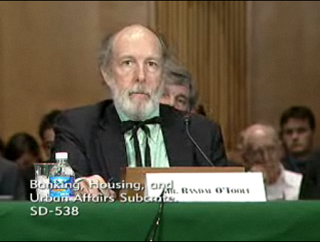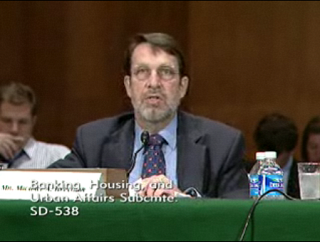More Transit Myths Debunked
July 26, 2009Contrarian Comments Off on More Transit Myths DebunkedPublic transit nemesis Randall O’Toole also testified before the Senate committee hearing mentioned in the previous post (video and transcripts here). Some of his points (none of which were challenged by any member of the Committee or other witnesses):

Randall O'Toole
♦ “Transit subsidies have historically had only a trivial effect on ridership. Between 1987 and 2007, annual subsidies in real dollars grew by 68 percent. Yet annual ridership grew by only 18 percent. While capital subsidies are sketchy before 1987, operating subsidies increased by 1240 percent since 1970. Yet ridership grew by only 45 percent.”
♦ “More importantly, despite total real subsidies of well over three-quarters of a trillion dollars [emphasis added] since 1970, per-capita transit ridership and passenger miles actually declined . . . more-or-less steadily from 1970 through 1995. Although per-capita transit usage has grown a little since 1995, it remains below 1988, and far below 1970, levels.”
♦ “Moreover, while per-capita transit travel was declining, per capita urban driving grew by 120 percent. Transit carried more than 4 percent of urban travel in 1970; but it fell below 2 percent in 1990 and now stands at 1.6 percent.”
♦ “My former hometown of Portland, Oregon has invested more than $2 billion in light rail and streetcars. Yet this has had almost no effect on Portland travel habits. In 1980, before Portland built its first light-rail line, the census found 9.8 percent of Portland urbanized area commuters took transit to work. Today, Portland has four lightrail routes and a streetcar line, yet the Census Bureau’s American Community Survey says only 6.5 percent of Portland commuters take transit to work.”
♦ “The number of Portland-area residents taking transit to work actually declined between 2000 and 2007. These census numbers are confirmed by a 100-percent census of downtown employers conducted by the Portland Business Alliance in 2001 through 2007. More than two-thirds of all Portland-area transit commuters work in downtown Portland, but this census found that 7 percent fewer downtown workers took transit to work in 2007 than in 2001.”
♦ “In much of the country, the fossil-fuel-burning plants used to generate electricity for rail transit emit enormous amounts of greenhouse gases. Washington’s Metrorail system, for example, generates more than 280 grams of CO2 per passenger mile — considerably more than the average passenger car. Light-rail systems in Baltimore, Cleveland, Denver, Philadelphia, and Pittsburgh all emit more greenhouse gases per passenger mile than the average SUV.”
♦ “Contrary to claims that rail transit can carry as many people as four or more freeway lanes, the New York City subway is the only rail transit line in America that carries more passenger miles per rail mile than one urban freeway lane mile. Outside of New York, the average urban freeway lane mile carries 12 times as many passenger miles as the average commuter rail mile, 7.5 times as many as the average light-rail mile, and 2.4 times as many as the average subway/elevated mile.”

Michael Replogle
At the conclusion of witness testimony Subcommittee Chairman Robert Menendez (D-NJ) invited the other witnesses — transit apparatchiks all — to question O’Toole, the only witness so singled out. Though none challenged any of O’Toole’s facts or figures, all reaffirmed their commitments to further subsidies, citing other alleged benefits of gold-plated transit systems. Typical response: “Mr. O’Toole’s analysis is too narrow . . . ” (Replogle).
Apparently, transit confers benefits on communities even if no one rides it.
We may recall the criticisms leveled at foreign aid programs in the 60s and 70s, that the aid more often than not ends up building monuments to local egos, such as gleaming airport terminals in Third World capitals connected by lushly landscaped, multi-lane highways to the generalissimo’s palace — highways which traverse miles of shantytowns and carry no traffic except the limos of government officials. Transit subsidies produce analogous “benefits.”
Tags: Transportation, Urban Planning

